
Alders are trees comprising the genus Alnus in the birch family Betulaceae. The genus comprises about 35 species of monoecious trees and shrubs, a few reaching a large size, distributed throughout the north temperate zone with a few species extending into Central America, as well as the northern and southern Andes.

The Bromeliaceae are a family of monocot flowering plants of about 80 genera and 3700 known species, native mainly to the tropical Americas, with several species found in the American subtropics and one in tropical west Africa, Pitcairnia feliciana.

Cymbidium, commonly known as boat orchids, is a genus of evergreen flowering plants in the orchid family Orchidaceae. Orchids in this genus are epiphytic, lithophytic, terrestrial or rarely leafless saprophytic herbs usually with pseudobulbs. There are usually between three and twelve leaves arranged in two ranks on each pseudobulb or shoot and lasting for several years. From one to a large number of flowers are arranged on an unbranched flowering stem arising from the base of the pseudobulb. The sepals and petals are all free from and similar to each other. The labellum is significantly different from the other petals and the sepals and has three lobes. There are about fifty-five species and sixteen further natural hybrids occurring in the wild from tropical and subtropical Asia to Australia. Cymbidiums are well known in horticulture and many cultivars have been developed. The genome of Cymbidium mannii has been sequenced to study epiphytism and crassulacean acid metabolism.

The genus Pulsatilla contains about 40 species of herbaceous perennial plants native to meadows and prairies of North America, Europe, and Asia. Derived from the Hebrew word for Passover, "pasakh", the common name pasque flower refers to the Easter (Passover) flowering period, in the spring. Common names include pasque flower, wind flower, prairie crocus, Easter flower, and meadow anemone. Several species are valued ornamentals because of their finely-dissected leaves, solitary bell-shaped flowers, and plumed seed heads. The showy part of the flower consists of sepals, not petals.

Plumbaginaceae is a family of flowering plants, with a cosmopolitan distribution. The family is sometimes referred to as the leadwort family or the plumbago family.
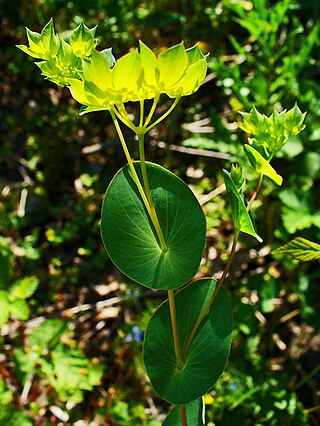
Bupleurum is a large genus of annual or perennial herbs or woody shrubs, with about 190 species, belonging to the family Apiaceae. The full size of its species may vary between a few cm to up to 3 m high. Their compound umbels of small flowers are adorned with bracteoles that are sometimes large and may play a role in attracting pollinators. Rare among the Apiaceae are the simple leaves, bracts, and bracteoles. The genus is almost exclusively native in the Old World Northern Hemisphere, with one species native to North America and one species native to southern Africa.

Kohleria is a New World genus of the flowering plant family Gesneriaceae. The plants are generally tropical herbs or subshrubs with velvety stems and foliage and brightly colored flowers with spots or markings in contrasting colors. They are rhizomatous and commonly include a period of dormancy in their growth cycle. The genus was revised in 1992 and was then recognized as having 19 species distributed in Central America and South America. phylogenetic in 2005 indicated that the epiphytic genus Capanea is derived from within Kohleria, and the two species of Capanea were subsequently transferred to Kohleria. The genus Pearcea is closely related.
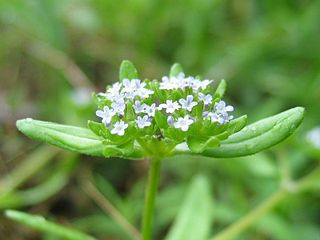
Valerianella is a genus of plant in family Caprifoliaceae. Many plants of this genus are known by the common name corn salad or cornsalad, although that name most often refers to Valerianella locusta.

Crucianella is a genus of flowering plants in the family Rubiaceae. The species are annual herbs found from the Mediterranean to Central Asia and the Arabian Peninsula. One species is naturalized in northern California, southern Oregon, and Idaho.

Ageratina riparia, commonly known as mistflower, is a species of flowering plant in the family Asteraceae, native to Mexico. The species is widely adventive and has spread to Cuba, Jamaica, and other parts of the Caribbean. It has also been introduced as an ornamental plant and naturalized in a variety of regions, including parts of Hawaii, South Africa, Southeast Asia, Macaronesia, Oceania, Peru, and the Indian subcontinent. In tropical climates, A. riparia is highly invasive and a variety of control methods have been developed to reduce its spread.

Eduard August von Regel was a German horticulturalist and botanist. He ended his career serving as the Director of the Russian Imperial Botanical Garden of St. Petersburg. As a result of naturalists and explorers sending back biological collections, Regel was able to describe and name many previously unknown species from frontiers around the world.

Plocama is a genus of flowering plants in the family Rubiaceae. It was described by William Aiton in 1789. It is distributed from the Canary Islands to northwestern India.

Epiphyllum hybrids, epiphyllums, epicacti, or just epis, also known as orchid cacti, which are widely grown for their flowers, are artificial hybrids derived primarily from species of the genus Disocactus. These Disocactus species are not true epiphyllums, but they used to be included in the genus Epiphyllum.
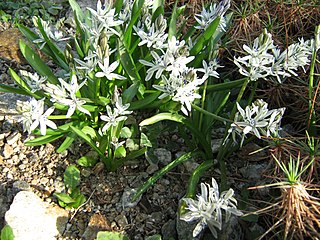
Fessia is a genus of bulbous flowering plants in the family Asparagaceae, subfamily Scilloideae. It is distributed from Iran to Central Asia and Pakistan.

Tulipa alberti, or Albert's tulip, is a species of flowering plant in the family Liliaceae. It has long reddish, orange or pink flowers. It comes from the mountains of Central Asia.

The taxonomy of Tulipa places the genus in the family Liliaceae, and subdivides it as four subgenera, and comprises about 75 species.
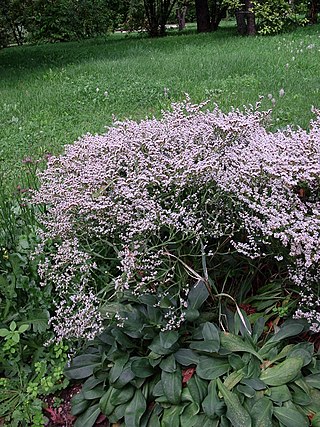
Goniolimon, sometimes called the statices, are a genus of flowering plants in the leadwort and plumbago family Plumbaginaceae, native to northern Africa, southern Europe, western and central Asia, Siberia, Mongolia and China. Low-lying perennial shrubs, some species are cultivated as ground covers.
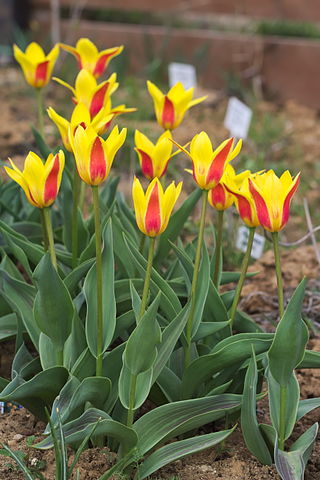
Tulipa kaufmanniana, the water lily tulip, is a species of tulip native to Central Asia.
Neogontscharovia is a genus of flowering plants belonging to the family Plumbaginaceae.


















